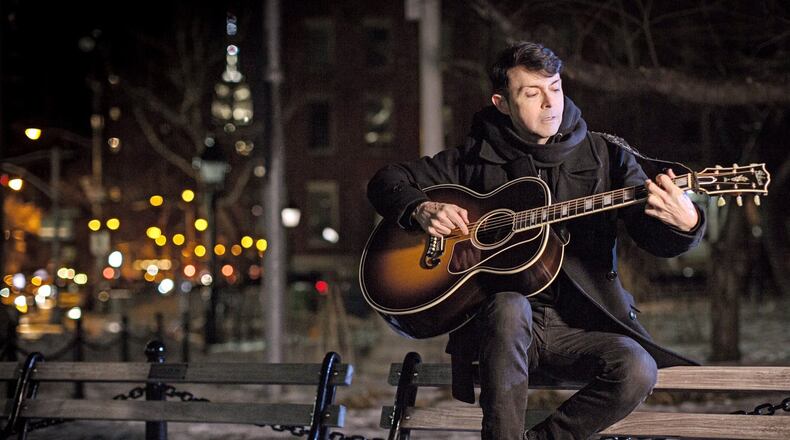EVENT PREVIEW
Richard Barone. With Linda Hopper and Ruthie Morris (of Magnapop) and special guests. 9:30 p.m. May 7. $20-$26. Eddie's Attic, 515-B N. McDonough St., Decatur. eddiesattic.com.
Follow Richard Barone on Twitter (twitter.com/RichardBarone), Instagram (www.instagram.com/richardbarone) and Facebook (www.facebook.com/RichardBaroneOfficial).
Richard Barone has enjoyed a sustained, if decidedly under-the-mainstream-radar, career in music. It’s been more than 30 years since his band the Bongos debuted with “Drums Along the Hudson” in 1982, but he’s still a working musician. He’s proof that a brief flash of fame may not always pay the bills, but determination, dedication and talent can fuel decades of success, even if the whole world isn’t paying attention.
How did he do it? What is it that keeps him going?
The music, for one thing. He’s crafted memorable songs for decades. There’s something about the rumbling tom-toms that introduce 1983’s “Barbarella” that scream 1980s. It’s a big sound that seems like a far cry from the skittering minimalism and nervy underground pop of “Drums Along the Hudson.” But it transmits echoes of Barone’s love of the thumping punch of T. Rex, something which was there from the beginning with the debut’s fantastic cover of that band’s “Mambo Sun.”
Following the Bongos’ heyday, Barone embarked on a low-key solo career. “Cool Blue Halo” was a breathtaking break from the norm in 1987, a live album of new material and covers, draped in cello and spinning a moody atmosphere unlike anything else of the time.
Since then, he’s maintained a career doing what he loves. He’s still recording, touring, teaching, organizing tribute shows, writing books, serving on the board for New York’s Anthology Film Series, and serving as executive producer on films (such as the documentary “The Nomi Song,” about late New York performance artist and musician Klaus Nomi), among other things.
The lesson? Diversify. It’s good for business, it’s good for economies and, as Barone demonstrates, it’s good for music careers, too.
He’ll be coming to Atlanta to play for the first time in many years, so we talked with him about his career, his performances and what it takes to make a living as a working musician.
On his connection to his Athens contemporaries:
“We made special connections to Athens, that’s for sure. For one thing, all of those bands stayed at my apartment in Hoboken. We had an apartment that they all crashed in, so we were really close to those bands.
"I sang with (Vanessa Briscoe Hay of Pylon) at SXSW a few years ago. I love her. Besides being a friend, she was an inspiration. Pylon was a big inspiration to the Bongos. There's only one Vanessa. I adore her, always have. That sweetness and that stage persona. I really think other people have imitated her over the years. She was an original. She is an original."
On social media, where he’s very active:
“We just did it in our own way using copy machines. The DIY movement of that period, we created our own social media. It was done by postcards and Xerox machines. We created our own community in our own way. This is just a quicker, modern way to do the same thing.”
On surviving in the music business, which he wrote about at length in his book “Frontman: Surviving the Rock Star Myth”:
“When I say ‘Surviving the Rock Star Myth,’ I don’t mean physically surviving. That book is about surviving in the business.It’s about learning to do a lot of different things that you can have fun with that can be a part of your business. Like collaboration. Producing other artists, co-writing, writing for magazines. There are so many things that a musician can do that aren’t necessarily going on stage every night.
“I teach at NYU, I lecture at universities about stage performance. I study it, too, I don’t just talk about my own experiences.
“I do a lot of different things, but that’s always been my nature. It wasn’t something I had to force on myself. Collaboration is a key for longevity — and the right collaborators really can make a difference in your life.”
On playing small venues, as he’ll be doing at Eddie’s Attic:
“I like performing in intimate venues where I can interact with the audience. I love big venues, too, but it’s a different kind of total abandon, where I’m on a huge stage. The total abandon thing in a smaller venue doesn’t work. Then it becomes an intimate conversation with the audience. And I love that. I like to do both. I jump around all kinds of sizes of venues. I’m looking forward to (Eddie’s Attic) because of the intimacy of it.”
A behind-the-scenes tale starring Nancy Sinatra, Bea Arthur and a very special photograph:
“I love Nancy Sinatra. She blew me away at a concert once, it must have been in the early 2000s. She did songs by the Smiths. She was doing Dylan. She just had such a great repertoire of songs, plus the songs that she had hits with are so cool, the ones with Lee Hazlewood.
“One of my favorite vocalists is Peggy Lee. When I was growing up, I remember hearing her records playing in the background. Her voice was so enchanting, almost like a predecessor to Nico or Marianne Faithfull. It was a little bit ethereal, kind of out there.
“I got to be friends with (Lee) toward the end of her life, and promised I would do a tribute to her. After she’d passed away, I was able to do it at Carnegie Hall. I asked Nancy Sinatra to be in that with a huge cast of singers, including Debbie Harry, Shirley Horn, really amazing divas, both male and female, doing Peggy Lee’s music.
“Nancy was in that. Bea Arthur was scheduled, but she wasn’t well. Even though we rehearsed, she couldn’t do the Carnegie Hall show.
"Then I was asked to bring the whole show to the Hollywood Bowl. I brought most of the cast together again and brought them all to L.A. And that time, because she lived there, Bea Arthur was able to do it.
“Me doing Bea Arthur’s makeup was a very special moment, because I loved Bea Arthur. Not just the ‘Golden Girls,’ but all of her stuff.
“I was producing and directing that show — and hosting it — so I was in a tuxedo. Right before the show, she grabbed me by the arm and said, ‘Richard, would you do my makeup?’ And I’d never done anybody’s makeup, really. I said, ‘Well, Bea, I’m not really a makeup artist’. She said, ‘Honey, you’re the only person I trust.’
“Because we had been working on her piece for the New York show, which she was not able to perform, we had worked together a lot. And then again for the Hollywood Bowl, we rehearsed like crazy for her numbers. I said ‘Well, of anyone in the cast, the person who is going to have the most makeup available, including false eyelashes, is Nancy Sinatra.’ So I grabbed Bea by the arm and said, ‘Let’s go to Nancy’s dressing room.’ So I did her makeup while Nancy took pictures.
“It’s really sweet the way she’s posing. Like she’s checking with her expression to see how my makeup’s working on her.”
About the Author
Keep Reading
The Latest
Featured




